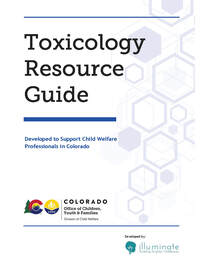A Resource for Child Welfare Professionals in Colorado.
The Toxicology Resource Guide was developed to support Colorado child welfare professionals in understanding substances, possible effects and the utility and application of toxicology testing to enhance practice.
A drug test is just one piece of the puzzle.
|
The results from a drug test must be viewed within the context of the rest of the puzzle. The intention of this guide is to walk professionals through the complex factors of substance use and toxicology to provide guidance. Ultimately, if there are questions or concerns, contact a specialist. A glossary of key terms, list of frequently asked questions and additional resources are available in the online guide and eBook.
Key Considerations Important Considerations When Using the Toxicology Resource Guide Caregiver substance use may have a significant impact on caregiver engagement and child safety in a variety of ways - which could include: inattentiveness; impaired decision making; inability to supervise or participate in daily living; risks around driving while impaired; increased risk for violence and abuse; passive substance exposures or unintentional ingestions; and other impacts on functioning and environmental safety. Drug testing can be an important piece of evaluating the safety of the home, caregivers and the child. Drug testing itself is RARELY diagnostic when interpreted alone, and best done in conjunction with clinical examination and/or observation of behavior, environment, and evaluation of the entire situation. |
|
Each drug, each patient, and each case is different.
There are no universal rules with drug testing. A drug test MAY or MAY NOT tell you whether or not:
A NEGATIVE “toxicology test” does not ALWAYS mean NO exposure. This may be dependent on the drug itself, the timeline of exposure and the detection limits of the test.
|

Working with families who may be using substances is one of the most difficult things child welfare workers do. This is where engagement, observation, and leaning into your critical thinking skills come in handy! Families are generally worried about what may happen when child protection gets involved with their family. Television and print media often portray removal as the first, best and only option with children, and we know this is only one of the many paths that a child welfare assessment may take. How do we balance the perceived power of child welfare so we can work with families to address safety and risk concerns?
We hope you use this Toxicology Resource to help guide your decision making when you see symptoms or behaviors that might impact child safety. This guide can also help you to figure out what substance the caregiver might be using, and if a test is warranted, which test? If you are seeing behavior that is concerning for child safety, this guide can help to determine how long a substance might be in a caregiver’s system in order to determine when a support person or network might be necessary. Families usually have support networks they can use in a crisis and completing the Colorado Family Safety Assessment tool can often help identify who they are. Many of the families we work with appear isolated and don't feel they have a support network. Get creative when asking this kind of question - who would they ask to pick up their kinds in an emergency? Who's programmed into their cell phone? Who are their facebook, instagram, or snapchat friends? Specific questions like this help to focus people in a crisis situation to build a specific safety network that can help to support the family.
Being transparent and leaning into the Colorado Family Safety Assessment Tool can be helpful. This tool can help provide a balanced assessment, looking at areas of danger, harm and risk along with strengths and protective capacities of caregivers and children. When the Colorado Family Safety Assessment tool is completed with family members, they know why child welfare is involved and that they have strengths to build on to mitigate danger, harm or risk.
We hope you use this Toxicology Resource to help guide your decision making when you see symptoms or behaviors that might impact child safety. This guide can also help you to figure out what substance the caregiver might be using, and if a test is warranted, which test? If you are seeing behavior that is concerning for child safety, this guide can help to determine how long a substance might be in a caregiver’s system in order to determine when a support person or network might be necessary. Families usually have support networks they can use in a crisis and completing the Colorado Family Safety Assessment tool can often help identify who they are. Many of the families we work with appear isolated and don't feel they have a support network. Get creative when asking this kind of question - who would they ask to pick up their kinds in an emergency? Who's programmed into their cell phone? Who are their facebook, instagram, or snapchat friends? Specific questions like this help to focus people in a crisis situation to build a specific safety network that can help to support the family.
Being transparent and leaning into the Colorado Family Safety Assessment Tool can be helpful. This tool can help provide a balanced assessment, looking at areas of danger, harm and risk along with strengths and protective capacities of caregivers and children. When the Colorado Family Safety Assessment tool is completed with family members, they know why child welfare is involved and that they have strengths to build on to mitigate danger, harm or risk.



